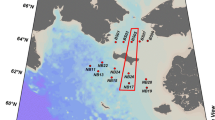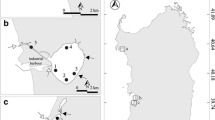Abstract―
The spatial distribution of picocyanobacteria at the arctic longitude section passing through the shelf of the Kara, Laptev, and East Siberian seas from 58° to 168° E was studied. The average abundance of picocyanobacteria was 0.48 ± 1.2 × 109 cells/m3 in the Kara Sea, 0.16 ± 0.24 × 109 cells/m3 in the Laptev Sea, and 0.25 ± 0.43 × 109 cells/m3 in the East Siberian Sea. The fluctuations of picocyanobacterial abundance were determined by their presence in allochthonous sources: river flow and transformed North Atlantic waters. The highest abundance was observed in the areas of the runoff influence of the Ob, Khatanga, Indigirka, and Kolyma Siberian rivers: 0.5 × 109, 0.2 × 109, 0.4 × 109, and 1.6 × 109 cells/m3, respectively. The average contribution of picocyanobacteria to the total abundance and biomass of picophytoplankton in the western part of the Kara Sea was 37 and 36%, respectively. In other regions, the average contribution of picocyanobacteria to the total abundance and biomass of phototrophic picoplankton did not exceed 7 and 6%, respectively. A highly reliable (p\( \ll \) 0.01) positive correlation between the abundance and biomass of picocyanobacteria and the water temperature (p = 0.003) was revealed in the entire dataset obtained.



Similar content being viewed by others
REFERENCES
Moon-van der Staay, S.Y., Wachter, R., and Vaulot, D., Oceanic 18S rDNA sequences from picoplankton reveal unsuspected eukaryotic diversity, Nature, 2001, vol. 409, no. 6820, pp. 607–610.
Li, W.K.W., Primary production of prochlorophytes, cyanobacteria, and eucaryotic ultraphytoplankton: Measurements from flow cytometric sorting, Limnol. Oceanogr., 1994, vol. 39, no. 1, pp. 169–175.
Pedrós-Alió, C., Potvin, M., and Lovejoy, C., Diversity of planktonic microorganisms in the Arctic Ocean, Prog. Oceanogr., 2015, vol. 139, pp. 233–243.
Paulsen, M.L., Doré, H., Garczarek, L., Seuthe, L., Müller, O., Sandaa, R.-A., Bratbak, G., and Larsen, A., Synechococcusin the Atlantic gateway to the Arctic Ocean, Front. Mar. Sci., 2016, vol. 3, p. 191.
Waleron, M., Waleron, K., Vincent, W.F., and Wil-motte, A., Allochthonous inputs of riverine picocyanobacteria to coastal waters in the Arctic Ocean, FEMS Microbiol. Ecol., 2007, vol. 59, no. 2, pp. 356–365.
Cottrell, M.T. and Kirchman, D.L., Photoheterotrophic microbes in the Arctic Ocean in summer and winter, Appl. Environ. Microbiol., 2009, vol. 75, no. 15, pp. 4958–4966.
IPCC: Climate Change 2013: The Physical Science Basis, Contribution of Working Group I to the Fifth Assessment Report of the Intergovernmental Panel on Climate Change, Stocker, T.F., Qin, D., Plattner, G.-K., Tignor, M., Allen, S.K., Boschung, J., Nauels, A., Xia, Y., Bex, V., and Midgley, P.M., Eds., Cambridge, 2013.
Gordeev, V.V., River input of water, sediment, major ions, nutrients and trace metals from Russian territory to the Arctic Ocean, in The Freshwater Budget of the Arctic Ocean, Lewis, E.L., Ed., Kluwer: Amsterdam, 2000, pp. 297–322.
Polyakov, I.V., Pnyushkov, A.V., Alkire, M.B., et al., Greater role for Atlantic inflows on sea ice loss in the Eurasian basin of the Arctic Ocean, Science, 2017, vol. 356, no. 6335, pp. 285–291.
Blais, M., Ardyna, M., Gosselin, M., Dumont, D., Belanger, S., Tremblay, J.-E., Gratton, Y., and Marchese, C., and Poulin, M., Contrasting interannual changes in phytoplankton productivity and community structure in the coastal Canadian Arctic Ocean, Limnol. Oceanogr., 2017, vol. 62, no. 6, pp. 2480–2497.
Vincent, W.F., Microbial ecosystem responses to rapid climate change in the Arctic, ISME, 2010, no. 4, pp. 1087–1090.
Moreira-Turcq, P.F., Cauwet, G., and Martin, J.M., Contribution of flow cytometry to estimate picoplankton biomass in estuarine systems, Hydrobiologia, 2001, vol. 462, nos. 1–3, pp. 157–168.
Bauch, D., Torres-Valdes, S., Polyakov, I., Novikhin, A., Dmitrenko, I., McKay, J., and Mix, A., Halocline water modification and along-slope advection at the Laptev Sea continental margin, Ocean Sci., 2014, vol. 10, no. 1, pp. 141–154.
Zavialov, P.O., Izhitskiy, A.S., Osadchiev, A.A., Pelevin, V.V., and Grabovskiy, A.B., The structure of thermohaline and bio-optical fields in the upper layer of the Kara Sea in September 2011, Oceanology, 2015, vol. 55, no. 4, pp. 461–471.
Hansen, H.P. and Koroleff, F., Determination of nutrients, in Methods of Seawater Analysis, Grashoff, K., Kremling, K., and Ehrhardt, M., Eds., Weinheim–New York–Chichester–Brisbane–Singapore–Toronto: Wiley-VCH, 1999, pp. 149–228.
Belevich, T.A., Ilyash, L.V., Milyutina, I.A., Logacheva, M.D., and Troitsky, A.V., Phototrophic picoeukaryotes of Onega bay, the White Sea: Abundance and species composition, Moscow Univ. Biol. Sci. Bull., 2017, vol. 72, no. 3, pp. 109–114.
Ribeiro, C.G., Dominique, M.D., dos Santos, A.L., Brandini, F.P., and Vaulot, D., Estimating microbial populations by flow cytometry: Comparison between instruments, Limnol. Oceanogr. Methods, 2016, vol. 14, no. 11, pp. 750–758.
Verity, P.G., Robertson, C.Y., Tronzo, C.R., Andrews, M.G., Nelson, J.R., and Sieracki, M.E., Relationship between cell volume and the carbon and nitrogen content of marine photosynthetic nanoplankton, Limnol. Oceanogr., 1992, vol. 37, no. 7, pp. 1434–1446.
Menden-Deuer, S. and Lessard, E.J., Carbon to volume relationships for dinoflagellates, diatoms, and other protest plankton, Limnol. Oceanogr., 2000, vol. 45, no. 3, pp. 569–579.
Clarke, K.R. and Gorley, R.N., PRIMER v6: User Manual/Tutorial, Plymouth: PRIMER–E, 2006.
Fahrbach, E., Meincke, J., Osterhus, S., Rohardt, G., Schauer, U., Tverberg, V., and Verduin, J., Direct measurements of volume transports through Fram Strait, Polar Res., 2001, vol. 20, no. 2, pp. 217–224.
Cottrell, M. and Kirchman, D., Virus genes in Arctic marine bacteria identified by metagenomic analysis, Aquat. Microb. Ecol., 2012, vol. 66, no. 2, pp. 107–116.
Waterbury, J.B., Watson, S.W., Valois, F.W., and Franks, D.G., Biological and ecological characterization of the marine unicellular cyanobacterium Synechococcus, in Photosynthetic Picoplankton, Platt, T. and Li, W.K.W., Eds., Ottawa: Can. Bull. Fish. Aquat. Sci., 1986, pp. 71–120.
Lovejoy, C., Vincent, W.F., Bonilla, S., Roy, S., Martineau, M.-J., Terrado, R., Potvin, M., and Massana, R., and Pedrós-Alió, C., Distribution, phylogeny, and growth of cold-adapted picoprasinophytes in Arctic seas, J. Phycol., 2007, vol. 43, no. 1, pp. 78–89.
Olson, R.J., Zettler, E.R., Armbrust, E.V., and Chisholm, S.W., Pigment, size and distribution of Synechococcus in the North Atlantic and Pacific oceans, Limnol. Oceanogr., 1990, vol. 35, no. 1, pp. 45–58.
Funding
This study was carried out as part of the State Task of Moscow State University, part 2 (topic no. AAAA-A16-116021660052-0). The Russian Foundation for Basic Research supported expeditionary research (project no. 18-05-60069 Arctic) and processing and analysis of the results (project no. 19-05-00026а).
Author information
Authors and Affiliations
Corresponding author
Ethics declarations
The authors declare no conflict of interest. This article does not contain any studies involving animals or human participants performed by the authors.
Additional information
Translated by A. Panyushkina
About this article
Cite this article
Belevich, T.A., Il’yash, L.V., Chul’tsova, A.L. et al. The Spatial Distribution of Plankton Picocyanobacteria on the Shelf of the Kara, Laptev, and East Siberian Seas. Moscow Univ. Biol.Sci. Bull. 74, 194–199 (2019). https://doi.org/10.3103/S0096392519040011
Received:
Revised:
Accepted:
Published:
Issue Date:
DOI: https://doi.org/10.3103/S0096392519040011




